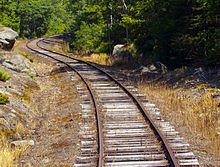

In civil engineering, a reverse curve (or "S" curve) is a section of the horizontal alignment of a highway or rail route in which a curve to the left or right is followed immediately by a curve in the opposite direction.
On highways in the United States reverse curves are often announced by the posting of a W1-4L sign (left–right reverse curve) or a W1-4R sign (right–left reverse curve), as called for in the Manual on Uniform Traffic Control Devices.
On rail routes, reverse curves can cause buffer-locking. On the Northeast Corridor in the United States, these also hinder the development of high-speed rail.
See also
References
- Mundrey (2000). Railway Track Engineering. McGraw-Hill Education. pp. 164–179. ISBN 9780074637241.
- Harry Rubey (1956). Route Surveys and Construction. Macmillan Publishers. pp. 86–88.
- Federal Highway Administration (1971). Manual on uniform traffic control devices for streets and highways. U.S. Government Printing Office. p. 67.
- "Analysis: Long road ahead for improving Northeast Corridor speeds".
This rail-transport related article is a stub. You can help Misplaced Pages by expanding it. |
This engineering-related article is a stub. You can help Misplaced Pages by expanding it. |